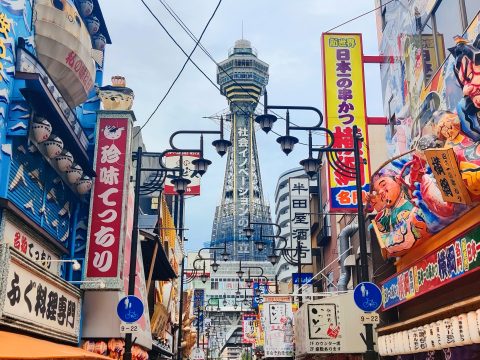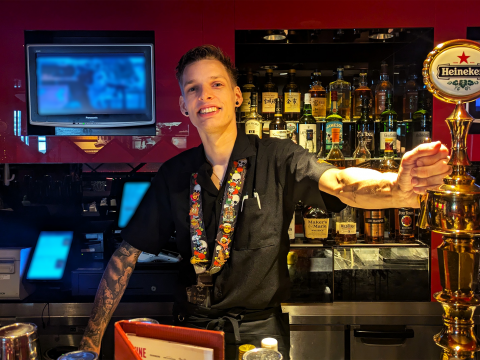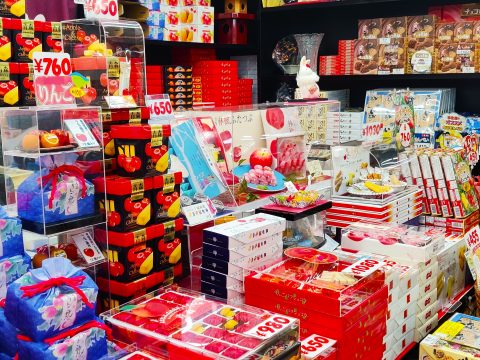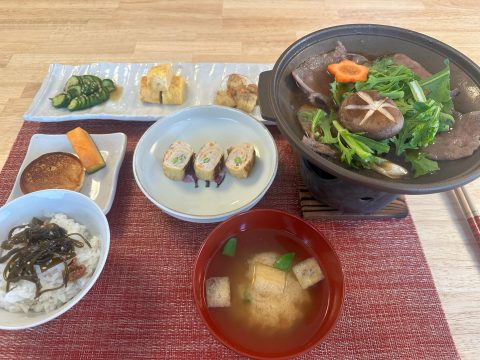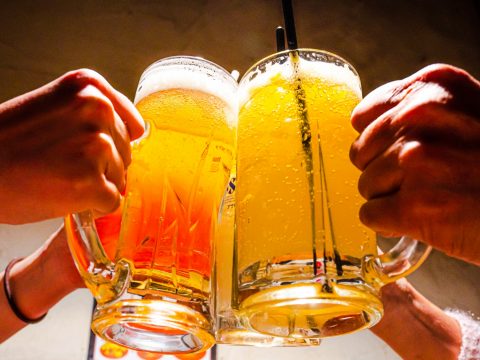Having Tourists as Customers
WORK’IN JAPAN
08.01.2025
Have you ever imagined what it’s like to work with tourists in Japan? Since the pandemic, many things changed in Japan. The biggest change of all might be the incredible increase of tourism. This past year, more foreign tourists visited Japan than ever before. With over 33 million visitors in 2024, it’s safe to say that Japan is a popular travel destination for people from all over the world and the ‘Japan hype’ is probably not ending anytime soon.
How do tourists influence residents’ lives?
But how much do residents notice of this increase? And how much can this affect your daily activities at work? First of all, it of course depends on where you live. Tokyo, Kyoto, and Osaka are the cities that most tourists visit. Although there has been a fair share of negativity about this ‘over tourism’ in the media, let’s also not forget about the positive consequences of this increase. Tourism generates income and jobs. Most tourists don’t only spend money on hotels, restaurants, and trains, but also on taxis, street food, souvenirs, guided tours, experiences, museums, exhibitions, and much more. All these different services require a lot of staff and more recently, especially international and multilingual staff.

For example, without all these tourists, I wouldn’t be able to do the work at my current workplace. For over 2 years, I’ve been working part-time at a shop that produces and sells ‘ukiyoe’ (handmade woodblock prints). It is located in the busy center of Asakusa in Tokyo and on top of this, my boss is a Youtuber and Twitch streamer, which makes our shop a must-visit spot for many fans when they’re in Tokyo. Therefore, almost all our customers are foreign tourists, mainly from Western countries. So let me share with you why I like working with tourists so much.
Put yourself in a tourist’s shoes
First of all, they’re usually in a good mood. They’re excited to explore Tokyo, often fascinated by Japanese culture and they’ve been planning this trip for a long time. When they’re finally here, they want to see and experience as much as they can. This includes trying different foods every day, visiting many other areas, buying unique souvenirs, and learning more about Japan’s customs and traditions. Even though almost everyone is here on a rather tight schedule, simply because there is so much to do wherever they go, most people still like to take their time and fully enjoy their experience in every shop or restaurant. They often have the mindset that they’re in a special place at a special time and might never have the opportunity to come back. Therefore, many people tend to have a flexible budget or even splurge, because a unique souvenir or experience that reminds them of their trip to Japan, seems priceless at that moment. And let’s be honest, these types of customers, are the best. Personally, I find it incredibly motivating and refreshing to work with people who truly appreciate being in our shop.

You can offer a local perspective
Besides this, most of our customers love to hear more about life in Tokyo, often ask for restaurant recommendations in Asakusa and even take our advice about traveling to other areas in Japan. In other words, because our shop staff speaks many languages, we offer valuable information and an interesting experience, which most tourists wouldn’t easily get from shops where all the staff only speaks Japanese or limited English. Working in the shop, really made me realize that most tourists don’t have the opportunity to talk to locals. Unless they book a tour guide or have friends or acquaintances living here, it can be quite difficult to have a good conversation or get advice in their own language. Of course, not every shop or restaurant is suited for long conversations, but it’s also important to see this as a form of customer service. So don’t underestimate how valuable and helpful even a short conversation can be for many people or how much this will also brighten up your day!
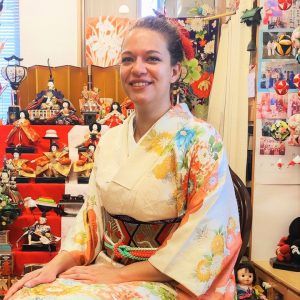
Mietta Varszegi
Mietta grew up in the Netherlands and moved to Japan in 2019 to work as an English teacher. Now, she has 3 different jobs, explores Tokyo on days off and takes trips around Japan whenever she can. But everywhere in Japan, the goal is the same: visit as many shrines, castles and parks as possible and eat everything!
Read previous articles by the writer
Read latest articles
KEYWORDS
- # PICKPICK
- # Resume
- # alcohol
- # Rice
- # Soup
- # winter food
- # Fast Food
- # seafood
- # spicy foods
- # raw food
- # fermented food
- # Transportation
- # MEAT
- # Edo culture
- # suits
- # clothing
- # drink
- # fish
- # seasoning
- # Japanese New Years Foods
- # Toshikoshi soba
- # Osechi Ryori
- # Ozoni
- # Christmas
- # Japanese fusion pasta
- # Wafu Pasta
- # Japanese Hot Pot
- # なべ
- # 鍋
- # Miyazaki
- # Chicken Nanban
- # Karamen
- # Autumn Wagashi
- # Mushi-yokan
- # Imo-yokan
- # Japanese Autumn Fruits
- # Autumn
- # Vending Machine
- # fall
- # dango
- # Chestnut rice
- # saury
- # Mushroom
- # Rice vinegar
- # Japanese condiments
- # 調味料
- # Sake
- # Mirin
- # Soy sauce
- # Japanese Noodles
- # Udon
- # Ramen
- # Yakisoba
- # Soba
- # Japanese Seaweed
- # 海藻
- # かいそう
- # Payslip
- # Training
- # Japanese summer foods
- # 和菓子
- # Wagashi
- # ryokucha
- # 夏
- # 飲み物
- # Ramune
- # ラムネ
- # Pokari Sweat
- # ポカリスエット
- # Calpis
- # カルピス
- # Mugicha
- # ume
- # 梅
- # うめ
- # umeshu
- # job hunting
- # tofu
- # Recruitment in Japan
- # miso
- # Japanese cuisine
- # Yellowtail and bonito
- # Children’s Day
- # Kashiwa Mochi
- # Chimaki
- # fruits
- # Kusamochi
- # Types of Agriculture in Japan
- # bread
- # パン
- # パン屋さん
- # japanese bread
- # shokupan
- # meal blead
- # anko bread
- # 桜
- # さくら
- # cherry blossom
- # visa
- # hanami
- # omotenashi
- # sakura
- # おもてなし
- # Japanese hospitality
- # oshibori
- # wet hand towel
- # hand towel
- # restaurant
- # Commuting in Japan
- # Women-only cars
- # Exit gate
- # japanese train
- # train
- # valentine
- # Japanese sweets
- # 朝食
- # Japanese Breakfast
- # Breakfast
- # Japanese
- # 日本
- # healthy
- # persimmons
- # hoshigaki
- # HR
- # work in Japan
- # jinji ido
- # corporate systems
- # Japanese work culture
- # bento
- # ekiben
- # shinkansen
- # omiyage
- # train station
- # Japanese culture
- # work culture
- # mentaiko
- # umeboshi
- # Japanese snacks
- # potato chips
- # Japanese potato chips
- # Japanese writing
- # seaweed
- # konbu
- # ocean foods
- # shio konbu
- # dashi
- # miso soup
- # food processing
- # pear
- # nashi
- # sweet potato
- # japanese sweet potato
- # stingray
- # satsuma imo
- # food value chain
- # homecooking
- # agriculture
- # Japanese homecooking
- # farming
- # nikujaga
- # shojin ryori
- # meat and potatoes
- # traditional foods
- # comfort food
- # buddhist food
- # manufacturing
- # factory
- # eihire
- # vegetarian
- # food and beverage
- # izakaya
- # yatai
- # japanese festival
- # taiyaki
- # matsuri
- # summer
- # Ikayaki
- # smart agriculture
- # shaved ice
- # kakigori
- # かき氷
- # summer dessert
- # Japan
- # Japanese foods
- # dessert
- # fruit
- # matcha
- # icecream
- # Pikcup
- # Pikc up
- # Pcikup
- # skilled labor visa
- # working visa japan
- # Dineer Table in Japan
- # Japanese manner
- # Japanese food
- # Japanese Table Manner
- # Chopsticks
- # Japanese traffic signs
- # traffic information
- # road rules in Japan
- # chocolate
- # green tea
- # Osaka
- # Work Japan
- # Japanese company
- # ikura
- # sushi
- # nigiri
- # wasabi
- # PCIK
- # PICK UP
- # PICK
- # PICKUP


